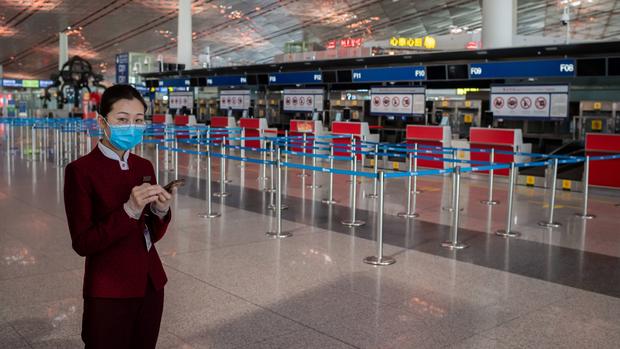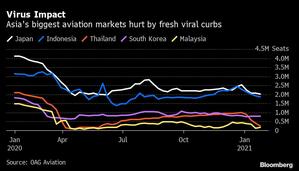 In this April 13, 2020 file photo, an airline hostess wearing a facemask amid the concerns over the COVID-19 coronavirus holds her smart phone next to empty check-in counters (right) at Beijing Capital International Airport. (NICOLAS ASFOURI / AFP)
In this April 13, 2020 file photo, an airline hostess wearing a facemask amid the concerns over the COVID-19 coronavirus holds her smart phone next to empty check-in counters (right) at Beijing Capital International Airport. (NICOLAS ASFOURI / AFP)
A fragile recovery in Asian aviation is being snuffed out by a resurgence of COVID-19 in the region, pushing back forecasts for when air travel will get back to pre-virus levels and weighing on jet fuel margins.
Chinese seat capacity on domestic and international flights has fallen more than 20 percent from the end of September, when it almost got back to January 2020 levels, according to OAG Aviation, a flight data and analytics provider. People are being encouraged not to travel over the Lunar New Year period, which runs through early March, suggesting capacity may not rise until late this quarter.
ALSO READ: AstraZeneca virus shot shows 82% efficacy with 3-month gap
The rapid rebound in Chinese aviation had been a rare bright spot for jet fuel, which has taken the biggest hit among oil products from the pandemic
“The depth of the latest COVID-19 spike, its impact on aviation and subsequent consumer demand suggests that the hoped for recovery toward the back end of 2021 may not be as strong as expected,” said Mayur Patel, head of Asia at OAG Aviation. A full recovery in Asian air travel may now take until 2025, instead of the company’s previous forecast of 2024, he said.
China’s transport ministry has said the total number of trips -- by air, road and rail -- over the LNY period will be 40 percent lower than 2019. Seat capacity was 98 percent of January 2020 levels at the end of September, just before the Golden Week holiday, the OAG data show, before falling to 77 percent in late January.
While the recovery in flights wasn’t as strong in other Asian nations, it’s also gone into reverse. Thailand and Malaysia -- particularly dependent on tourism -- are among the hardest-hit markets.
Thai seat capacity is at 13 percent of pre-virus levels after getting back to 46 percent in late-December, according to OAG. Malaysia, which reached 31 percent of pre-pandemic seat capacity late last year, is at 11 percent.
ALSO READ: Cathay Pacific CEO resigns amid turmoil in airline
Malaysia placed most of the country under some form of lockdown last month and officials will decide whether to extend it on Thursday. There are no immediate signs of a recovery in flights in Thailand and Malaysia and there’s concern over the long-term viability of domestic airlines. OAG’s Patel said.
Asian jet fuel margins are reflecting the drop in activity. They fell below US$3 a barrel last week after peaking at US$5.52 late last year, Bloomberg Fair Value data show. They had recovered to US$4.80 on Wednesday.
Demand for jet fuel and kerosene will average 2.4 million barrels a day this quarter, with more heating fuel consumption offsetting less flights, said Kang Wu, head of global demand and Asia analytics at S&P Global Platts.

European flight activity looks worse than China, although better than Thailand and Malaysia. Air traffic will be 72 percent below 2019 levels in February and March, according to the most optimistic estimate from Eurocontrol.
COVID-19’s comeback has seen Asian governments delay plans to allow more air travel between countries. Vaccination rollouts are expected to drive a gradual increase in flights, however, and corridors for business travelers could open up in the region.
“The resurgence has put paid to the initiation of travel bubbles across the region,” said Subhas Menon, director general of the Association of Asia Pacific Airlines. “What is worse is the seemingly haphazard and incoherent introduction of stricter control regimes affecting air travel.”


